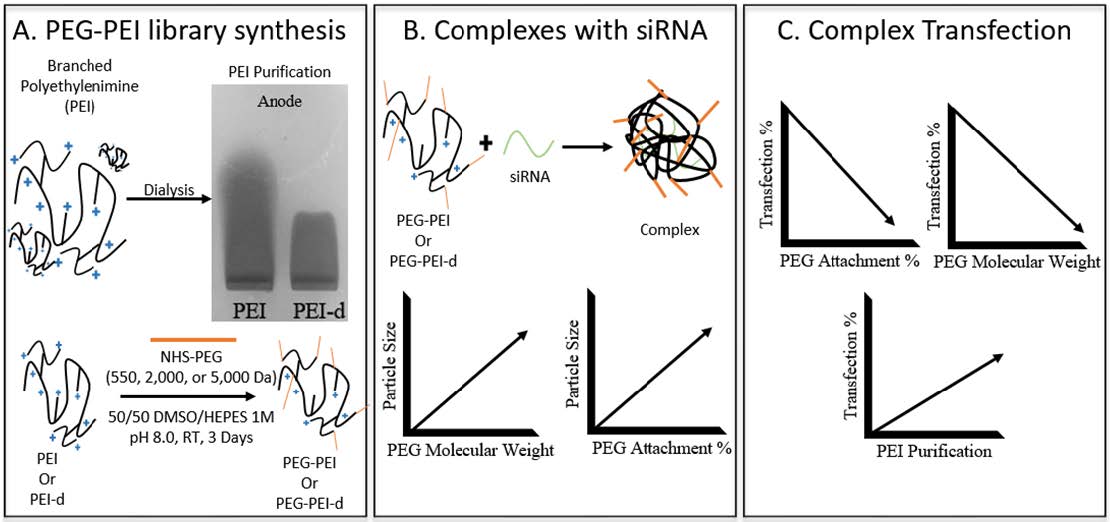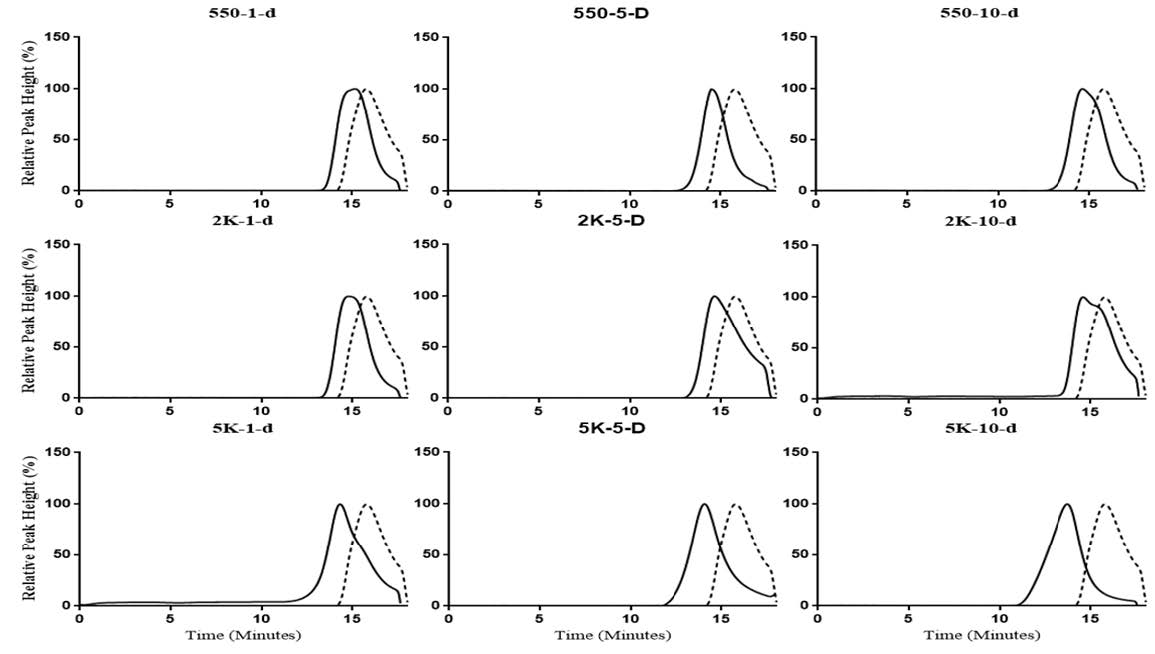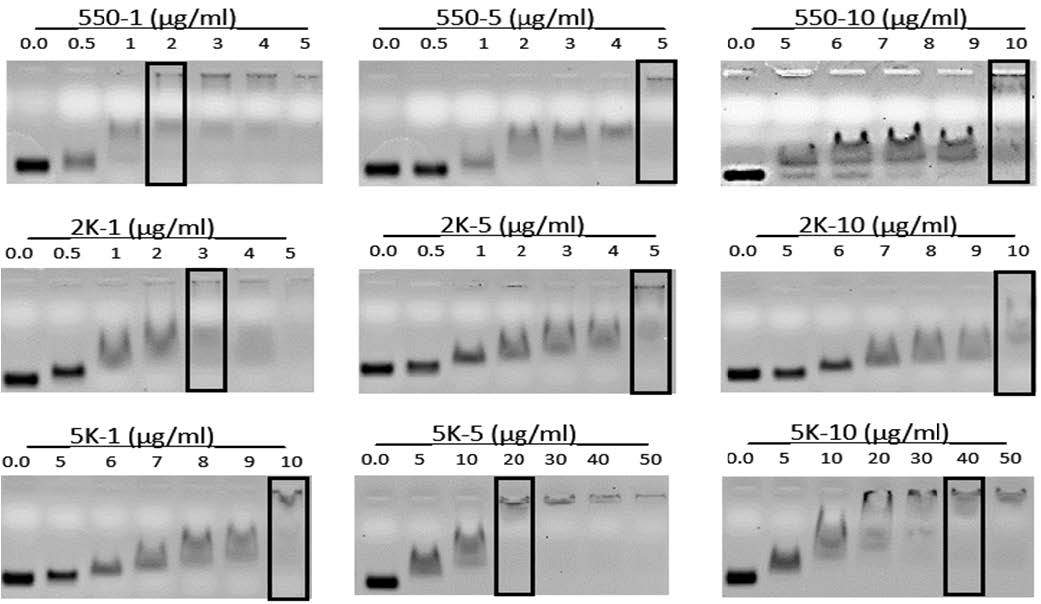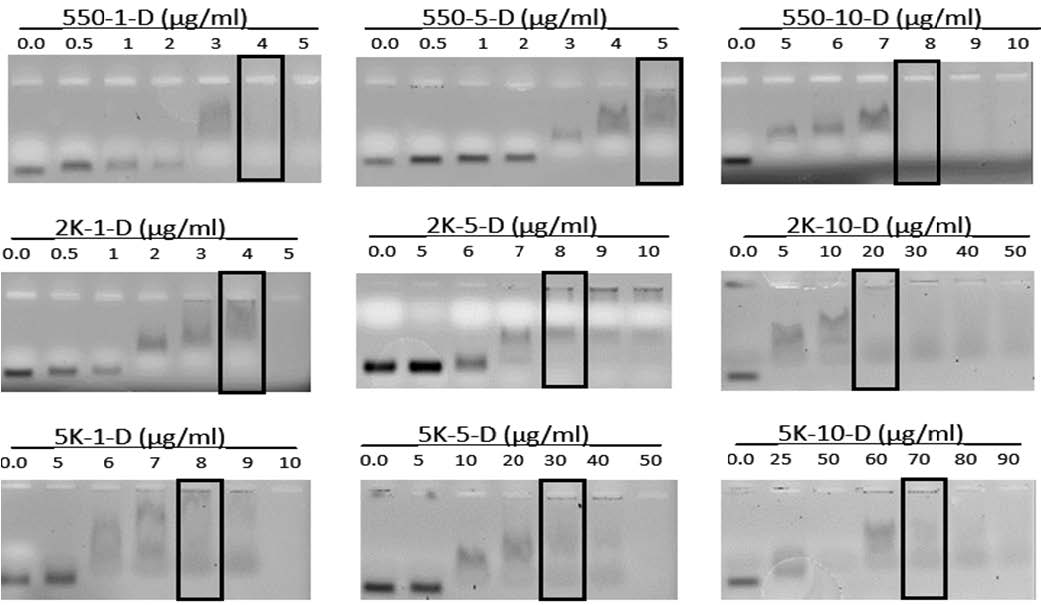1. Introduction
Small interfering RNA (siRNA) holds promise to inhibit transcription of specific genes inside cells and reduce expression of target proteins responsible for a disease [1,2]. Reducing target proteins allows for the treatment of various genetic diseases with few therapeutic options [3,4], including cancers resistant to chemotherapy [5]. Although these benefits have been confirmed in in vitro cell culture systems, siRNA-based cancer therapy has made limited success in clinical applications due to delivery issues. Renal clearance and RNases degradation remove siRNA from the bloodstream with less than a 15-minute half-life [6,7]. siRNA is poorly taken up by cancer cells because the negatively charged base pair fails to interact with anionic cellular membranes. Even after cellular uptake, siRNA often fails to escape endosomes for gene silencing [8]. Therefore, novel siRNA delivery systems are urgently needed to overcome these delivery issues and improve siRNA therapy for clinical applications.
Cationic polymers, such as poly(ethylene imine) (PEI), have beneficial properties for developing delivery systems enhancing in vivo stability, endosomal escape, and transfection of siRNA [9]. Cationic PEI can interact with anionic siRNA and form stable ionic complexes, which can protect siRNA from rapid renal clearance and RNase degradation by preventing renal filtration and enzyamtic interactions [10]. The siRNA/PEI complexes typically have cationic surface charge, which allows for direct interaction with cellular membranes and subsequent entry to endosomes through endocytosis or phagocytosis [11]. Once in the endosome, siRNA/PEI complexes can interact with endosomal membranes and disrupt the intracellular vesicles [12]. Eventually, siRNA/PEI complexes enter the cytosol and release siRNA, which reduces protein expression via the RNA interference pathway (RNAi) [13,14].
However, siRNA/PEI complexes have several limitations for their applications. Cationic surface charge of siRNA complexes has induced toxicity and hindered their clinical applications [15]. siRNA/PEI complexes can also dissociate in the presence of counter ions, and release polymer and free siRNA before reaching their target site. Released polymers may disrupt cellular membranes and cause further toxicity, while siRNA would leave the body and not have therapeutic effects. To address these issues, chemical modifications to cationic siRNA/PEI complexes are often made to neutralize the surface charge. A common modification to shield surface charge of siRNA complexes is to chemically conjugate poly(ethylene glycol) (PEG), a biocompatible and non-ionic polymer, to cationic PEI chains [16]. In previous studies, chemical conjugation of PEG significantly reduced toxicity of PEI by avoiding uncontrolled aggregation/dissociation of the PEG-conjugated PEI and genetic cargos [17,18]. PEG prevents interactions of siRNA complexes with anionic materials in the bloodstream and cellular membranes by forming a neutral, hydrophilic shell around siRNA/PEI complexes [19]. Preventing interactions can lessen the toxicity and enhance the stability of PEI complexes compared to unmodified PEI complexes.
Taking this background into account, we previously studied PEG-PEI-based nanoparticles for siRNA delivery [20]. The PEG-PEI particles were < 30 nm in diameter with improved particle uniformity and stability (Figure 1). PEG-PEI particles exhibited siRNA transfection comparable to a commercial reagent (RNAiMAX) [20]. However, we have recently found that transfection efficiency of siRNA/PEG-PEI complexes changes unpredictably across product batches. Particularly, batches of PEG-PEI with similar chemical properties failed to reproduce transfection efficacy under the same cells and culture conditions while the RNAiMAX control remained consistent. The lack of reproducibility in siRNA transfection with PEG-PEI particles have raised concerns in further development of PEI-based siRNA delivery carriers. We hypothesize that variable siRNA transfection of PEG-PEI particles is attributed to PEG density. This hypothesis is based on previous reports that large PEG densities reduce intracellular uptake. In addition, commercially purchased PEI often contains small impurities (small molecule amine compounds) that are produced by hydrolysis and oxidation during storage. These PEI contaminants can form a mixture of PEG-PEI particles and polymer chains varying in PEG density across product batches.
Therefore, this study focuses on PEG molecular weight (PEG MW), PEG substitution rate (PEG%), and PEI impurities as factors influencing PEG densities for siRNA/PEI complexes, and aims to elucidate how these factors would influence siRNA transfection in a model human colon cancer cell line(HT29). Towards the aim, a library of siRNA/PEG-PEI complexes was created with varying PEG densities. PEG density was varied by changing the PEG MW and PEG%. siRNA complexes were synthesized using PEG-conjugated PEI nanoparticles made from PEI as purchased (PEG-PEI) or PEI purified by dialysis (PEG-PEI-d). Transfection efficiency of siRNA/PEG-PEI and siRNA/PEG-PEI-d complexes were measured with anti-luciferase siRNA in HT29 stably expressing the luciferase reporter gene.
2. Materials and Method
2.1. Chemicals and cells
PEI (25 kDa, branched) was purchased from Sigma Aldrich. PEGs (550 Da, 2 kDa, and 5 kDa α-methoxy-ω-NHS activated, NHS-PEG) were purchased from NOF America. HEPES buffer (pH 8.0, 1 M), NuSieve agarose GTG, dialysis membrane with molecular weight cutoff (MWCO) of 100 kDa, deuterated DMSO, Opti-MEM, SimplyBlue SafeStain, and phosphate buffered saline (PBS 1X) were purchased from Fisher Scientific (Waltham, MA). Anti-Luciferase siRNA was synthesized with the sequence of 5’-GUUGGCACCAGCAGCGCACUU-3’. A human colon cancer cell line (HT29) was from American Type Culture Collection (ATCC). HT29 cells were grown using McCoy’s 5A with 10% fetal bovine serum (FBS) according to ATCC recommendations. Cells were cultured in a humidified environment with 5% CO2 at 37 °C
2.2. Synthesis of PEG-PEI and PEG-PEI-d particles
We first purified PEI by dialysis (100 kDa MWCO) against water for 2 days. The dialyzed PEI (PEI-d) was collected by lyophilization. PEI and PEI-d (20 µL of a 10 mg/mL) were run on a 2% agarose gel at 120 V for 1 hour to verify the removal of small impurities. The gel was stained with SimplyBlue SafeStain overnight and destained in water for 6 hours. PEG-PEI (or PEG-PEI-d) particles were then synthesized by reacting NHS-PEG with PEI (or PEI-d) in a 1:1 mixture of DMSO:HEPES buffer (1 M) for 3 days at room temperature. Molar ratios of NHS-PEG:PEI were 3:1, 15:1, or 40:1 for 1%, 5%, and 10% (denoted as PEG% of PEI). The reactants were dialyzed against water (100K MWCO) to remove free PEG and other impurities. PEG-PEI and PEG-PEI-d particles were collected by lyophilization.
2.3. PEG-PEI and PEG-PEI-d characterization
PEG-PEI and PEG-PEI-d particles were analyzed via 1H-NMR to obtain the PEG%. Each PEG-PEI (5 mg) was added to deuterated DMSO (500 μL) and run in an NMR (400 MHz Varian NMR). To determine the PEG%, peak areas were compared between the PEI main chain (CH2, 2.6-3.4 ppm) and PEG conjugated to PEI (CH2, 3.6 ppm). The peak area comparisons determined the molar ratios between PEG chains and primary amines of PEI (214 in average), which were converted to the percent substitution of PEG on PEI. The PEG-PEI and PEG-PEI-d forming unimolecular nanoparticles were analyzed for purity and uniformity by gel permeation chromatography (GPC, Asahipak GF-7M column, 0.5 mL/min, 40 °C, PBS mobile phase). The surface charge and diameter of the particles were determined by measuring zeta potential and dynamic light scattering (DLS, Zetasizer Nano, Malvern, UK).
2.4. Determination of minimum siRNA complexation ratios
A solution of PEG-PEI particle (1 mg/mL) was mixed with a solution of siRNA in PBS to create a final concentration of particle ranging from 0 to 100 μg/mL polymer mixed with 72 nM siRNA. PEG-PEI particles and siRNA were mixed at room temperature for 30 minutes. The mixing ratio is described as the N/P ratio, where N is amines on PEI and P is the phosphate groups on siRNA. siRNA/PEG-PEI complexes at varying N/P ratios were analyzed by gel electrophoresis (1% agarose gel, 20 μL loading per well, 120 V, 1 hour). The gels were stained with ethidium bromide and imaged with Typhoon GLA 9500 (GE Healthcare, Logan, UT).
2.5. Particle size of siRNA/PEG-PEI complexes
Aqueous solutions of PEG-PEI particles (1 mg/mL) were mixed with siRNA according to their previously found minimum complexation ratio for 30 minutes at room temperature. siRNA complexes (500 μL) were loaded into disposable zeta cuvettes and analyzed for particle diameter via DLS measurement (Zetasizer Nano, Malvern, UK).
2.6. In vitro transfection efficiency and cell viability
Cells were seeded in a white 96 well cell culture plate (5, 000 cells/well, 100 μL Opti-MEM) and incubated for 24 hours prior to experiments. A solution of each polymer was solubilized in Opti-MEM at 1000× the concentration at which the polymer formed complexes with siRNA (determined by gel electrophoresis). One hundred microliters of polymer dilutions (500×, 200× and 10×) were added to 100 μL of 720 nM siRNA solution. The mixtures were incubated at room temperature for 30 minutes. Cell culture media (20 μL) in each well was replaced with 20 μL PEG-PEI/siRNA or PEI/siRNA complexes (n = 4). The N/P ratios were 1, 20, 50, and 100 for each well. The plates were incubated for 72 hours, and luciferin (100 μL, 0.1 mg/ml in PBS) was added to each well for luminescence measurement via a GloMax luminometer (Promega). To measure cell viability, a resazurin solution (10 μL, 1 mM) was added to each well. The plates were incubated for 3 hours and live cells were counted on a fluorescent plate reader (SpectraMax M5, Molecular Devices, 560Ex/590Em). The luciferase readings were normalized to cell viability to obtain the percentage of luciferase activity remaining after treatment.
3. Results
3.1. Synthesis of PEG-PEI and PEG-PEI-d nanoparticles.
PEG-PEI nanoparticles were successfully synthesized by using two versions of 25 kDa PEI (undialyzed PEI and dialyzed PEI-d) and PEG with varying molecular weights. Gel electrophoresis confirmed the difference between PEI and PEI-d in molecular weight distribution (Figure 1a, inset). Cationic PEIs traveled toward the anode, yet undialyzed PEI showed a broader smear on the gel than PEI-d. These results indicate that PEI contains small molecular weight contaminants and its average molecular weight (25 kDa) may be misleading to determine the accurate polymer charge density. In contrast, PEI-d showed a single band with no smudge, demonstrating the removal of small molecular weight PEI chains and other impurities after dialysis. A library of PEG-PEI particles with varying PEG density was then created from these two PEI stocks. The NMR confirmed successful modification of two parameters for the particles: PEG MW (550, 2, 000 and 5, 000 Da) and PEG substitution percent (1, 5, 10%) with respect to each type of PEI backbone (PEI and PEI-d). Table 1 summarizes the synthesis conditions including PEG% aimed and obtained. PEG-PEI and PEG-PEI-d particles were characterized by GPC (Figure 2 and 3) and DLS (Table 1). The GPC shows the removal of free PEG from the PEG-PEI particles. DLS revealed that the diameters of empty particles ranged from 4 nm to over 30 nm. Both empty PEG-PEI and PEG-PEI-d particles exhibited similar particle sizes though PEG MW and PEG% varied. PEG MW and PEG% were considered collectively to determine PEG density on PEG-PEI particles.
Table 1. Characterization of PEG-PEI and PEG-PEI-d Library.
| Particle Name | PEG MW (Da) | PEG% Aimed | Actual PEG% | PDI | Surface Charge (mV) | Diameter (nm ± SD) | Diameter after siRNA Complexation (nm ± SD) |
| PEI/PEI-d | PEI/PEI-d | PEI | PEI-d | PEI | PEI-d | PEI | PEI-d | PEI | PEI-d | PEI | PEI-d |
| N/A | 0 | 0 | 0 | 0 | 0.78 | 0.56 | 44.02 | 42.63 | 4.02 ± 0.97 | 4.53 ± 0.59 | 89.69 ± 5.34 | 72.34 ± 9.21 |
| 550–1 | 550 | 0.01 | 0.01 | 0.01 | 0.24 | 0.33 | 9.01 | 2.84 | 6.81 ± 1.69 | 7.21 ± 2.37 | 12.34 ± 2.15 | 14.41 ± 1.54 |
| 550–5 | 550 | 0.05 | 0.062 | 0.055 | 0.23 | 0.3 | 12.4 | 3.29 | 6.86 ± 1.54 | 6.42 ± 1.1 | 11.24 ± 5.23 | 13.68 ± 3.45 |
| 550–10 | 550 | 0.1 | 0.115 | 0.112 | 0.39 | 0.45 | –1.02 | 2.58 | 9.52 ± 2.42 | 9.89 ± 1.67 | 16.78 ± 2.21 | 18.36 ± 2.1 |
| 2K–1 | 2000 | 0.01 | 0.011 | 0.009 | 0.56 | 0.28 | 19.6 | –0.48 | 9.7 ± 1.5 | 8.04 ± 2.02 | 15.14 ± 3.48 | 15.45 ± 4.78 |
| 2K–5 | 2000 | 0.05 | 0.049 | 0.055 | 0.32 | 0.35 | 9.91 | 4.95 | 12.15 ± 3.28 | 17.14 ± 4.23 | 18.25 ± 4.11 | 18.36 ± 2.61 |
| 2K–10 | 2000 | 0.1 | 0.105 | 0.093 | 0.36 | 0.57 | 7.84 | 2.13 | 14.52 ± 4.03 | 23.14 ± 5.2 | 17.58 ± 2.25 | 22.95 ± 6.51 |
| 5K–1 | 5000 | 0.01 | 0.01 | 0.01 | 0.3 | 0.45 | 1.91 | 2.68 | 7.11 ± 1.7 | 14.25 ± 2.77 | 12.57 ± 1.56 | 19.21 ± 1.26 |
| 5K–5 | 5000 | 0.05 | 0.048 | 0.051 | 0.32 | 0.41 | 1.06 | 1.21 | 12.93 ± 2.08 | 20.15 ± 5.33 | 15.24 ± 4.12 | 21.34 ± 6.36 |
| 5K–10 | 5000 | 0.1 | 0.097 | 0.095 | 0.4 | 0.31 | 0.37 | 0.11 | 13.41 ± 2.8 | 33.87 ± 10.02 | 20.83 ± 3.22 | 31.25 ± 5.22 |
3.2. Effects of PEG MW and PEG% on physicochemical properties of PEG-PEI particles.
PEG MW and PEG substitution rate influenced PEG density directly, and particle diameter increased as PEG density increased. Particles increased their diameter as PEG MW and PEG% increased. A similar trend was observed with the surface charge of the particles. PEG-PEI and PEG-PEI-d with low PEG MW and PEG% (e.g., 550 Da or 2 kDa with 1% PEG substitution) showed positive surface charge. The surface charge decreased as PEG MW and PEG% increased, while the larger molecular weight PEGs shielded surface charge better at lower PEG%. Table 1 summarizes particle diameters of PEG-PEI particles forming complexes with siRNA at N/P = 1. PEG-PEI and PEG-PEI-d particles increased diameter after complexation or as PEG density increased.
3.3. Effects of PEG density on complexation
Gel electrophoresis revealed that PEG-PEI and PEG-PEI-d particles increased the minimum amount of polymer necessary to form complexes with a set amount of siRNA (72 nM) as their PEG density increased. At the minimum complexation condition, PEG-PEI neutralized the charge (N/P = 1) and retained siRNA in the well of the gel (Figure 4 and 5, black boxes). These results indicate that PEG conjugation reduces primary amines from PEI and requires more PEG-PEI particles to retain the same amount of siRNA within complexes. In theory, a 10% 5 kDa PEG substitution (5K-10) would increase average molecular weight of the product from 25 kDa (PEI with no PEG) to approximately 130 kDa (520% increase), and approximately 6 times more 5K-10 particles (572%) would be needed to match the number of primary amines on unmodified PEI forming complexes with siRNA at N/P = 1. However, our observations revealed that the actual increase in 5K-10 mass required for complexation was ~800% (Figure 4). These results indicate that PEG-PEI and PEG-PEI-d would require greater amounts of polymer than theoretical estimation to form siRNA complexes as PEG density increased.
3.4. PEG density and siRNA transfection
Figure 6 summarizes transfection efficacy of PEG-PEI particles with anti-luciferase siRNA at varying N/P ratios. As PEG% increased, the maximal transfection efficacy decreased in the PEG-PEIs containing 2 kDa and 5 kDa PEG. The PEG-PEIs containing 550 Da PEG with 1% and 5% PEG substitution retained transfection efficiency. However, PEG-PEIs with 10% PEG substitution increased the N/P ratio to achieve maximal transfection efficiency. Combining the two trends revealed that increasing PEG density decreased overall transfection efficiency of siRNA/PEG-PEI complexes. Low PEG density exhibited a positive effect on the complexes by reaching the maximal transfection efficiency of the unmodified PEI at a lower N/P ratio.
3.5. PEI impurities and transfection efficiency
Figure 7 shows the effects of the PEG-PEI-d on transfection efficiency at varying N/P ratios. Similar to PEG-PEI particles, PEG-PEI-d decreased the maximal transfection efficacy as PEG% increased, while PEG MW showed no negative effects on transfection at low PEG%. However, PEG-PEI-d showed maximal transfection at a lower N/P ratio than PEG-PEI (20 vs 50). This effect was reduced as the PEG density was increased.
4. Discussion
PEI is a cationic polymer well-studied for siRNA delivery because it can form ionic complexes with siRNA and improve stability of the genetic cargo in the body. However, clinical applications of the siRNA/PEI complexes are often held back by toxicity [21]. The toxicity of siRNA/PEI complexes is mainly attributed to the cationic surface charge disrupting anionic cellular membranes [22]. A common method of reducing surface charge of PEI/siRNA complexes is covalently attaching PEG to PEI [23]. PEG is available in many different molecular weights and thus can create PEIs with a variety of PEG densities [24]. We previously prepared nanoparticles from PEG-conjugated PEI (PEG-PEI) for siRNA delivery [20], and have recently found that their transfection efficiency changed unpredictably across batches, presumably due to variations of PEG density. However, the effects of PEG density on physicochemical properties and transfection efficiency of siRNA/PEG-PEI complexes were elusive. Therefore, this study elucidates how PEG density affects transfection efficiency of siRNA/PEG-PEI complexes by investigating three factors that influence PEG density on PEI (PEG MW, PEG% and PEI impurities).
Increased PEG MW was found to weaken siRNA/PEG-PEI interactions and lower transfection efficacy. These results indicated that increasing PEG MW increased the amount of PEG-PEI required to form complexes (Figure 4 and 5). Our initial speculation was that the increased amount of PEG-PEI was due to increased molecular weight of the polymer after PEG attachment. PEG conjugation reduces the weight percentage of primary amines on PEI, and thus requires more polymer to form complexes with siRNA and neutralize the charge. Therefore, we used the reduced weight percentage of primary amines to predict the increase in the weight ratio between PEG-PEI and siRNA to form complexes. For example, if PEI’s primary amines are reduced by 20%, 20% additional polymer is needed to form complexes. However, our data shows that PEG-PEIs containing 2 kDa and 5 kDa PEG need more polymer than predicted to form complexes.
Larger PEG chains (2 kDa or 5 kDa) would block cationic sites on PEI more effectively than shorter chains due to increased flexibility, as evidenced by the reduction of surface charge as the PEG chain length was increased (Table 1). Furthermore, both PEI and PEG are hydrophilic, which would allow them to entangle rather than form two distinct zones like nanoparticles containing hydrophobic polymers [25,26]. This entanglement would further block the cationic sites from interacting with siRNA, but would be lessened by smaller chain lengths of PEG, as observed in lower molecular weight PEG-PEIs (Figure 4 and 5). Further decreasing complex stability, the chains of PEG and PEI can entangle each other due to their hydrophilic nature. However, each polymer can interact with water at the surface of the nanoparticle causing hydrophilic polymer chains to shift in the hydrophobic core of complex. This shifting would block cationic moieties in the core, weaken the complex, and thus release siRNA prematurely. Additionally, blocking the cationic moieties would prevent the complexes from escaping endosomes, a critical step for transfection.
Lowering PEG% increased PEG-PEI/siRNA interactions and retained transfection efficacy of the complex. Reducing the PEG% reduced the minimum amount of polymer required for complex formation regardless of PEG MW (Figure 4 and 5). Lower PEG% would reduce the blockage of cationic moieties from interaction with both siRNA and cellular membranes. This speculation was supported by the increased surface charge after reducing the PEG% (Table 1). The complexes with lower PEG% showed greater transfection efficiency than with higher PEG% (Figure 6 and 7). In fact, lowering the PEG% increased transfection beyond the unmodified PEI control. This result correlates with others findings that PEG-PEI can be more efficacious than PEI [27]. It should be noted that PEGs with larger MW show a larger disparity in transfection efficacy between PEG attachment percentages. This may be the result of PEG composing a larger weight percentage of the complex. For example, when complexes are synthesized with 10 % attachment of 5 KDa PEG, their weight percentage of PEG is ~81%. The PEG weight percentage will be ~30% if the complexes have 1% attachment of the same PEG. These trends show the importance of PEG% to influence the interactions between siRNA and PEI. While the exact mechanism by which PEG chain length reduces transfection is unknown, it is speculated that either the complex is less stable [28,29] or unable to escape the endosome [30,31].
Impurities in PEI were confirmed to alter the physicochemical properties of complexes and reduce transfection efficacy at low N/P ratios. Commercially available PEI stocks include impurities along with PEI with a desired average molecular weight. The impurities are often small molecular weight PEIs, which either remained after synthesis or degraded from larger PEIs during storage. MWCO 100 kDa dialysis would remove small molecular weight impurities from not only PEI but also PEG-PEI. We hypothesized that, if small molecular weight impurities of PEI have no effects on transfection efficiency of PEG-conjugated PEI, both PEG-PEI and PEG-PEI-d should be identical and behave the same. Our results testing this hypothesis clearly indicate that commercial PEI must be purified by dialysis before PEG conjugation because small molecular weight PEI impurities influence PEG density on PEG-PEI products even after MWCO 100 kDa dialysis. We confirmed that dialysis of the PEI stock was able to successfully remove these impurities (Figure 1a). The removal of residual impurities increased the proportion of larger molecular weight PEI (PEI-d). Physicochemical properties of PEG-PEI-d were different from PEG-PEI in complex size swelling after complexation (Table 1). The increased complex diameter is likely due to the increased proportion of larger cationic polymer chains in PEG-PEI-d. The reduced size after complexation indicates that complexes are formed out of few PEG chains preventing the collapse of flexible PEG-PEI nanoparticles in the presence of siRNA (Table 1). The small PEI impurities can take part in siRNA complexation and increase the amount of PEG-PEI needed to neutralize the charge of siRNA and increase weight percentage of PEG. Therefore, PEG-PEI complexes would have greater PEG content, which is beneficial to reduce the surface charge yet disadvantageous to improving transfection. This speculation is supported by PEG-PEI-d complexes that showed transfection efficacy similar to PEG-PEI complexes yet transfected cells at a lower N/P ratio.
5. Conclusion
In this study, we have confirmed that PEG MW, PEG%, and PEI impurities influence PEG density on siRNA/PEG-PEI complexes, and thus significantly alter transfection efficiency of the complexes. PEG density correlated negatively with transfection efficacy of PEG-PEI nanoparticles as low PEG density increased siRNA transfection of siRNA/PEG-PEI complexes. Importantly, the removal of PEI impurities increased the transfection efficacy of all complexes at lower N/P ratios. Our findings demonstrate the importance of PEG length, PEG attachment percentage, and removal of PEI impurities in improving transfection efficacy of siRNA carriers using PEG-PEI. These results may be applicable to other cationic polymers forming complexes with siRNA and interacting with cellular membranes in a similar way to PEI, such as poly(lysine) and chitosan derivatives, and thus provide valuable insights for future development of more effective and much safer siRNA carriers.
Conflict of Interest
All authors declare no conflicts of interest in this paper.










 DownLoad:
DownLoad: 















